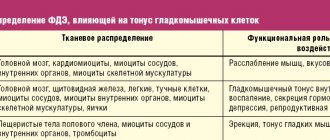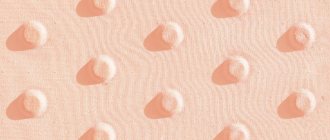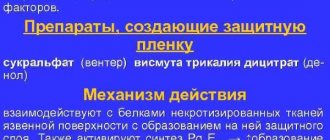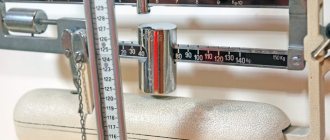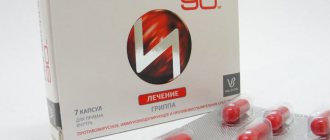Clostilbegit is a drug that is prescribed to directly stimulate ovulation in women and to treat low sperm count in men. The mechanism of its action is to increase the production of hormones in the hypothalamic-pituitary system. Thanks to the action of this drug, ovarian function is activated in women, which ensures the maturation of follicles. According to statistics, the number of pregnancies occurring when stimulated with clostilbegit is about 35-40%.
Indications for stimulation with clostilbegit
Very often, stimulation of ovulation with clostilbegit is prescribed to women with infertility of endocrine or idiopathic origin, in which natural ovulation does not occur. At the same time, before stimulation with clostilbegit, the doctor must check and eliminate the reasons that led to an infertile marriage. The main reasons for an infertile marriage:
- Male factor. If this factor is present, the man must take a spermogram before stimulation. If a decrease in the husband’s reproductive function is detected, the success of pregnancy, even in the presence of ovulation, will be significantly reduced.
- Pipe factor. With this pathology, a woman needs to check the patency of the fallopian tubes. For this purpose, hysterosalpingography and metrosalpingography are performed.
- Endometrial dysfunction (endometrial polyposis, mechanical damage to the endometrium during various intrauterine manipulations, endometrial inflammation, endometriosis).
- Cervical factor is characterized by incompatibility between the husband's sperm and the wife's vaginal mucus, as a result of which the sperm are destroyed directly in the cervix.
Reasons for the objective or subjective absence of natural ovulation, for which specific treatment is necessary, and stimulation with clostilbegit is not indicated:
- Hypofunction of the thyroid gland;
- Pathological increase in prolactin concentration;
- Incorrect definition of anovulation;
- Lack of sex life during ovulation. To increase the likelihood of conception, gynecologists advise having an active sex life between the 10th and 14th days of the menstrual cycle.
Contraindications
Clostilbegit is contraindicated for use if you have the following diseases and conditions:
- individual intolerance to the main or one of the auxiliary components of Clostilbegit;
- diseases accompanied by renal or liver failure;
- the period of gestation and natural feeding of the child;
- ovarian cysts, except Stein-Leventhal syndrome;
- pituitary insufficiency;
- tumors of the hypothalamic-pituitary system;
- diseases of the endocrine glands, in particular the thyroid gland and adrenal glands;
- uterine bleeding of unknown origin;
- vision problems that have recently arisen or have been present for a long time;
- endometriosis;
- ovarian failure due to high levels of prolactin in the blood.
If there are one or more contraindications, the doctor will recommend another, safer drug.
Measures taken to stimulate ovulation with clostilbegit
The doctor prescribes clostilbegit tablets at a dose of 50 mg at night, 1 tablet. It is necessary to start taking the medicine 2-5 days after the start of menstruation. Then, from days 7-11 of the menstrual cycle, the growth rate and size of the follicles, as well as the condition of the endometrium, are monitored using ultrasound diagnostics. When the size of the dominant follicle reaches 22-25 mm, the reproductologist performs an injection with hCG. The dose of the drug is prescribed by the doctor, taking into account the individual characteristics of each woman. Often the dosage of hCG drugs is 5000-10000 IU. Thanks to this hormonal drug, the regression of follicles or the formation of follicular cysts becomes impossible. After the injection, ovulation is observed within 24 hours. At the same time, it is necessary to be sexually active during this period with a frequency of once every two days.
Compound
| Pills | 1 table |
| active substance: clomiphene citrate | 50 mg |
| excipients: gelatin - 2 mg; magnesium stearate - 2 mg; stearic acid - 2 mg; talc - 5 mg; potato starch - 39 mg; lactose monohydrate - 100 mg |
- Full trade name of the drug: Clostilbegit, international nonproprietary name: clomiphene.
- Dispensed by prescription.
- Release form: tablets 50 mg No. 10 in a blister of aluminum foil or a dark glass bottle. Each package contains instructions for use.
- Manufacturer: ZAT Pharmaceutical Plant EGIS.
- Active ingredient: clomiphene citrate.
Combined use of clostilbegit and estrogens
Since clostilbegit has an anti-estrogenic effect, women are advised to monitor the condition of the endometrium when using it. This is due to the fact that with estrogen deficiency, the thickness of the endometrium may not be sufficient for complete implantation of a fertilized egg. That is why stimulation of ovulation with clostilbegit often requires the prescription of drugs that include estrogens. For example, drugs such as Proginova and Microfollin may be prescribed for this purpose.
If stimulation of ovulation with clostilbegit does not give the desired effect, then its dosage is increased to 100 mg per day. In the event that even a higher dose does not stimulate follicle maturation, agents from the group of gonadotropins should be used to stimulate ovulation.
Hormone replacement therapy for men with age-related androgen deficiency
Specialization: urology, andrology
Age-related androgen deficiency syndrome in men is a biochemical imbalance that occurs in adulthood due to insufficiency of androgens in the blood serum, often accompanied by a decrease in the body's sensitivity to androgens. As a rule, this leads to a significant deterioration in the quality of life and adversely affects the functions of almost all body systems. Naturally, the issues of androgen deficiency therapy are of great interest, since it poses a difficult task for the clinician: to choose from a wide arsenal of methods and drugs of hormonal therapy the most optimal one, combining quality, efficiency, and ease of use.
Currently, urologists and andrologists most often use testosterone replacement therapy. This method allows you to solve a number of problems: reduce the symptoms of age-related androgen deficiency by increasing libido and overall sexual satisfaction, reduce the severity or completely eliminate vegetative-vascular and mental disorders. In addition, if testosterone replacement therapy is used for more than 1 year, patients experience an increase in bone mass density, a decrease in the severity of visceral obesity, and an increase in muscle mass. Also, after a long course of treatment, laboratory parameters are normalized: there is an increase in hemoglobin levels or the number of red blood cells, a decrease in the level of VLDL (very low density lipoproteins) and LDL (low density lipoproteins) with an unchanged level of HDL (high density lipoproteins). Many authors believe that this effect can be achieved by restoring the concentration of testosterone in the blood to normal levels (10–35 nmol/l). It should also be taken into account that *17α-alkylated testosterone preparations fluoxymesterolone and methyltestosterone have pronounced hepatotoxicity, having a toxic and carcinogenic effect on the liver, and also negatively affect the lipid spectrum of the blood (a sharp increase in the level of atherogenic and a decrease in the level of antiatherogenic lipoproteins). Therefore, the use of these testosterone derivatives in clinical practice was discontinued. Currently, testosterone undecanoate (Andriol) is the preferred oral drug. This testosterone ester does not undergo primary hepatic metabolism, as it is absorbed into the lymphatic system, bypassing the liver. After hydrolysis of testosterone undecanoate in the lymphatic system, testosterone enters the systemic circulation, which has a therapeutic effect both on its own and through its main metabolites - dihydrotestosterone (DHT) and estradiol, which determine the full spectrum of androgenic activity of testosterone. Thus, testosterone undecanoate retains its activity when administered orally. At the same time, bypassing the portal vein system and passing through the liver, testosterone undecanoate does not have a hepatotoxic or hepatocarcinogenic effect. The half-life of the drug from plasma is 3–4 hours. In connection with this, the dosage regimen for testosterone undecanoate is 2 times a day, which is not always convenient for patients. Based on our own experience, we believe that Andriol is a fairly mild drug and helps only in cases of initial and minimal manifestations of age-related androgen deficiency.
Intramuscular injections of long-acting testosterone esters are also a widely used method of replacement therapy in men with hypogonadism. The two most well-known testosterone esters, testosterone cypionate and testosterone enanthate, have similar pharmacokinetics. When these drugs are administered intramuscularly, a depot is created from which the drug is released into the bloodstream. During the first 2–3 days after administration, testosterone levels rise to supraphysiological levels, and then slowly decrease over the next 2 weeks to subnormal values. The positive side of these drugs is the duration of the therapeutic effect. Nevertheless, sudden changes in testosterone levels, often felt by the patient himself in the form of increases and decreases in libido, general well-being, and emotional status, are undesirable qualities of these drugs. In this regard, great hopes are placed on the new drug Nebido (Schering), the pharmacokinetics of which are significantly different from other testosterone esters. Nebido is testosterone undecanoate and is a non-peak drug. Over the past two decades, much attention has been paid to research into the benefits of transdermal use of testosterone preparations. Scrotal patches are effective and some patients find them the most convenient treatment option. Skin patches are most well accepted by patients and provide effective serum testosterone levels. However, there are some differences between the two types of patches regarding their allergenic potential: skin patches have a much higher incidence of allergic reactions and skin irritation than scrotal patches. Testosterone gel has all the benefits of patches and does not cause skin reactions. Its only drawback is the possibility of contact of the gel with a partner and the insufficient number of long-term studies on its use. The transdermal route of testosterone administration avoids its primary metabolism in the liver and inactivation, as occurs with the use of oral androgen drugs, and also allows it to simulate the circadian rhythms of release of physiological unmodified testosterone and its natural metabolites, estradiol and DHT. In addition, therapy using patches and gel can be easily interrupted if necessary. The positive aspects of this treatment method also include the low risk of drug dependence. The European drug 5-α-dihydrotestosterone gel (DHT), although found to be effective, is unknown whether the isolated use of a non-aromatized androgen, such as DHT, has the same effect as testosterone, due to the fact that testosterone metabolites include estradiol. According to many authors, the use of the drug is not recommended, since DHT, due to the inability to convert into estradiol, does not have the full range of therapeutic properties of testosterone (for example, effects on bone tissue and the cardiovascular system). Some of the replacement therapy drugs, such as testosterone undecanoate, DHT gel and scrotal patches, cause a significant increase in serum DHT concentrations. DHT is known as the main androgen of the prostate, and there has been much discussion regarding its ability to cause prostate disease. However, despite these assumptions, in the last 10 years there has been no evidence of an increase in the incidence of prostate pathology when prescribing DHT drugs.
Thus, there are many drugs for androgen replacement therapy, but they all have certain side effects and also have an inhibitory effect on spermatogenesis. Recently, more and more studies have appeared demonstrating the secondary nature of age-related androgen deficiency. According to WHO materials, data were obtained on the preservation of the secreting function of Leydig cells in elderly men, which allowed scientists to propose a fundamentally new approach to the treatment of age-related androgen deficiency, based on stimulation of the synthesis of endogenous testosterone. However, we should not forget that along with absolute contraindications for androgen replacement therapy (breast and prostate cancer), there are also additional ones (benign prostatic hyperplasia with severe obstruction, prolactinoma, polycythemia). Relative contraindications include sleep disorders in the form of apnea, obstructive pulmonary diseases, and heavy smoking. Side effects of androgens include increased sleep apnea, polycythemia, gynecomastia, priapism, fluid retention, increased blood pressure, edema, increased prostate size, and inhibition of spermatogenesis. That is, today there are methods for treating age-related androgen deficiency, which can be divided into two groups, fundamentally different in their mechanism of action: replacement therapy with exogenous androgen drugs; therapy that stimulates the synthesis of endogenous testosterone. Thus, we can say that there is no optimal treatment for age-related androgen deficiency in men. And the choice of drug should be approached strictly individually, taking into account the patient’s age, body mass index, the need to preserve spermatogenesis, hematocrit values and concomitant diseases.
Bibliography:
- Kalinchenko S. Yu. Age-related androgen deficiency in men // Medical newspaper. – June 28, 2002 – No. 49.
- Cunningham GR Management of male aging: which testosterone replacement therapy should be used? The Aging Male 2000;3:203-209.
- Jordan WP Allergy and topical irritation associated with transdermal testosteron administration: a comparison of scrotal and nonscrotal transdermal systems. Am J Contact Dermat 1997;8:108-13.
- Yu Z, Gupta SK, Hwang SS, et al. Testosterone pharmakokinetics after application of an investigational transdermal system in hypogonadal men. J Clin Pharmacol 1997;37:1139-45.
- Gorpinchenko I. I., Miroshnikov Ya. O. Erectile dysfunction. – Lviv: Medicine of the World, 2003. – 80 p.
- Duncan C. Gould Hypoandrogen-metabolic (HAM) syndrome: an important men's health issue//IMNG.– 2007. – V.2. – P. 174–178.
- Shabsigh R. Testosterone therapy in erectile dysfunction and hypogonadism//J. Sex. Med. – 2005. – V.2. – P. 785–792.
- Traish AM, Kim N. Weapons of penile smooth muscle destruction: androgen deficiency promotes accumulation of adiposities in the corpus cavernosum // Aging male. – 2005. – V.8. – P. 141–146.
The material was published in the specialized publication for doctors ProTest, issue 5, May 2016. When using materials, a link to the journal is required.
